Rallying

Rally is a form of motorsport that takes place on public or private roads with modified production or specially built road-legal cars. It is distinguished by not running on a circuit, but instead in a point-to-point format in which participants and their co-drivers drive between set control points (special stages), leaving at regular intervals from one or more start points. Rallies may be won by pure speed within the stages or alternatively by driving to a predetermined ideal journey time within the stages.
History
Interwar years

The First World War brought a lull to rallying. The Monte Carlo Rally was not resuscitated until 1924, but since then, apart from World War II and its aftermath, it has been an annual event and remains a regular round of the World Rally Championship. In the 1930s, helped by the tough winters, it became the premier European rally, attracting 300 or more participants.[1]
In the 1920s, numerous variations on the Alpine theme sprang up in Austria, Italy, France, Switzerland and Germany. The most important of these were Austria's Alpenfahrt, which continued into its 44th edition in 1973, Italy's Coppa delle Alpi, and the Coupe Internationale des Alpes (International Alpine Trial), organised jointly by the automobile clubs of Italy, Germany, Austria, Switzerland and, latterly, France. This last event, run from 1928 to 1936, attracted strong international fields vying for an individual Glacier Cup or a team Alpine Cup, including successful Talbot, Riley, MG and Triumph teams from Britain and increasingly strong and well funded works representation from Adolf Hitler's Germany, keen to prove its engineering and sporting prowess with successful marques like Adler, Wanderer and Trumpf.[2]
The French started their own Rallye des Alpes Françaises in 1932, which continued after World War II as the Rallye International des Alpes, the name often shortened to Coupe des Alpes.[3] Other important rallies started between the wars included Britain's RAC Rally (1932)[4] and Belgium's Liège-Rome-Liège or just Liège, officially called "Le Marathon de la Route" (1931),[5] two events of radically different character; the former a gentle tour between cities from various start points, "rallying" at a seaside resort with a series of manoeuvrability and car control tests; the latter a thinly disguised road race over some of Europe's toughest mountain roads.
In Ireland, the first Ulster Motor Rally (1931) was run from multiple starting points. After several years in this format, it transitioned into the 1,000-mile (1,600 km) Circuit of Ireland Rally.[6] In Italy, Benito Mussolini's government encouraged motorsport of all kinds and facilitated road racing, so the sport quickly restarted after World War I. In 1927 the Mille Miglia (Thousand Mile) was founded, run over a 1,000-mile (1,600 km) loop of highways from Brescia to Rome and back. It continued in this form until 1938.[7]
The Liège of August 1939 was the last major event before World War II. Belgium's Jean Trasenster (Bugatti) and France's Jean Trevoux (Hotchkiss) tied for first place, denying the German works teams shortly before their countries were overrun.[8] This was one of five Liège wins for Trasenster; Trevoux won four Montes between 1934 and 1951.
Post-World War II years
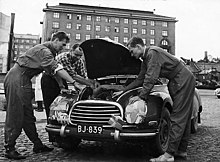
Rallying was again slow to get under way after a major war, but the 1950s were the Golden Age of the long-distance road rally. In Europe, the Monte Carlo Rally, the French and Austrian Alpines, and the Liège were joined by a host of new events that quickly established themselves as classics: the Lisbon Rally (Portugal, 1947), the Tulip Rally (the Netherlands, 1949), the Rally to the Midnight Sun (Sweden, 1951, now the Swedish Rally), the Rally of the 1000 Lakes (Finland, 1951 – now the Rally Finland), and the Acropolis Rally (Greece, 1956).[9] The RAC Rally gained International status on its return in 1951, but for 10 years its emphasis on map-reading navigation and short manoevrability tests made it unpopular with foreign crews.[10] The FIA created in 1953 a European Rally Championship (at first called the "Touring Championship") of eleven events; it was first won by Helmut Polensky of Germany. This was the premier international championship until 1973, when the FIA created the World Rally Championship for Manufacturers, won that first year by Alpine-Renault. Not until 1979 was there a World Rally Championship for Drivers, won that year by Björn Waldegård.
Initially, most of the major postwar rallies were fairly gentlemanly, but the organisers of the French Alpine and the Liège (which moved its turning point from Rome into Yugoslavia in 1956) straight away set difficult time schedules: the Automobile Club de Marseille et Provence laid on a long tough route over a succession of rugged passes, stated that cars would have to be driven flat out from start to finish, and gave a coveted Coupe des Alpes ("Alpine Cup") to anyone achieving an unpenalised run;[11] while Belgium's Royal Motor Union made clear no car was expected to finish the Liège unpenalised – when one did (1951 winner Johnny Claes in a Jaguar XK120) they tightened the timing to make sure it never happened again.[12] These two events became the ones for "the men" to do. The Monte, because of its glamour, got the media coverage and the biggest entries (and in snowy years was also a genuine challenge); while the Acropolis took advantage of Greece's appalling roads to become a truly tough event.[13] In 1956 came Corsica's Tour de Corse, 24 hours of virtually non-stop flat out driving on some of the narrowest and twistiest mountain roads on the planet – the first major rally to be won by a woman, Belgium's Gilberte Thirion, in a Renault Dauphine.[14][unreliable source?]
The Liège continued as uncompromisingly an open road event run to an impossible time schedule, and remained Europe's toughest rally until 1964, by which time it had turned to the wilds of Yugoslavia and Bulgaria to find traffic-free roads; but in the end the pressures were irresistible.[15] The Coupe des Alpes struggled on until 1973 until it too succumbed, its demise no doubt hastened by the decision of the French motor sporting authorities to select the Tour de Corse as its representative event in international rally championships.[16]
These events were road races in all but name, but in Italy such races were still allowed, and the Mille Miglia continued until a serious accident in 1957 caused it to be banned.[17] Meanwhile, in 1981, the Tour de France was revived by the Automobile-Club de Nice as a different kind of rally, based primarily on a series of races at circuits and hillclimbs around the country.[18] It was successful for a while and continued until 1986. It spawned similar events in a few other countries, but none survive.
Rallying became very popular in Sweden and Finland in the 1950s, thanks in part to the invention there of the specialsträcka (Swedish) or erikoiskoe (Finnish), or special stage: shorter sections of route, usually on minor or private roads—predominantly gravel in these countries—away from habitation and traffic, which were separately timed.[19][20] These at long last provided the solution to the conflict inherent in the notion of driving as fast as possible on ordinary roads. The idea spread to other countries, albeit more slowly to the most demanding events.

The RAC Rally had formally become an International event in 1951, but Britain's laws precluded the closure of public highways for special stages. This meant it had to rely on short manoeuvrability tests, regularity sections and night map-reading navigation to find a winner, which made it unattractive to foreign crews. In 1961, Jack Kemsley was able to persuade the Forestry Commission to open their many hundreds of miles of well surfaced and sinuous gravel roads, and the event was transformed into one of the most demanding and popular in the calendar, by 1983 having over 600 miles (970 km) of stage.[21] It is now called Rally GB.
Rallying also took off in Spain and Portugal and by the 1960s had spread to their colonial territories in the mid-Atlantic. By the end of the 1960s events had not only begun in Madeira and the Canary Islands, but also on the far-flung Azores.
Outside Europe
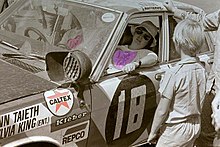
In countries where there was no shortage of demanding roads across remote terrain, other events sprang up. In South America, the biggest of these took the form of long distance city to city races, each of around 5,000 to 6,000 miles (8,000–9,500 km), divided into daily legs. The first was the Gran Premio del Norte of 1940, run from Buenos Aires to Lima and back; it was won by Juan Manuel Fangio in a much modified Chevrolet coupé.[22] This event was repeated in 1947, and in 1948 an even more ambitious one was held, the Gran Premio de la América del Sur from Buenos Aires to Caracas, Venezuela—Fangio had an accident in which his co-driver was killed.[23] Then in 1950 came the fast and dangerous Carrera Panamericana, a 1,911-mile (3,075 km) road race in stages across Mexico to celebrate the opening of the asphalt highway between the Guatemala and United States borders, which ran until 1954.[24] All these events fell victim to the cost – financial, social and environmental – of putting them on in an increasingly complex and developed world, although smaller road races continued long after, and a few still do in countries like Bolivia.
In Africa, 1950 saw the first French-run Méditerranée-le Cap, a 10,000-mile (16,000 km) rally from the Mediterranean to South Africa; it was run on and off until 1961, when the new political situation hastened its demise.[25] In 1953 East Africa saw the demanding Coronation Safari, which went on to become the Safari Rally and a World Championship round,[26] to be followed in due course by the Rallye du Maroc and the Rallye Côte d'Ivoire. Australia's Redex Round Australia Trial also dates from 1953, although this remained isolated from the rest of the rallying world.[27]
Canada hosted one of the world's longest and most gruelling rallies in the 1960s, the Shell 4000 Rally. It was also the only one sanctioned by FIA in North America.[28]
Subaru started the rally scene alejandro
Modern times
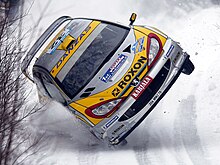
The introduction of the special stage brought rallying effectively into the modern era. It placed a premium on fast driving, and enabled healthy programmes of smaller events to spring up in Britain, France, Scandinavia, Belgium and elsewhere.
Since then, the nature of the events themselves has evolved relatively slowly. The increasing costs, both of organization and of competing, as well as safety concerns, have, over the last twenty years, brought progressively shorter rallies, shorter stages and the elimination of nighttime running, scornfully referred to as "office hours rallying" by older hands. Some of the older international events have gone, replaced by others from a much wider spread of countries around the world, until today rallying is truly a worldwide sport. At the same time, fields have shrunk dramatically, as the amateur in his near-standard car is squeezed out.
Gruelling long distance events continued to be run. In 1967, a group of American offroaders created the Mexican 1000 Rally, a tough 1,000-mile race for cars and motorcycles which ran the length of the Baja California peninsula, much of it initially over roadless desert, which quickly gained fame as the Baja 1000, today run by the SCORE organization.[29] "Baja" events now take place in a number of other countries worldwide.
1968 brought the first of a series of British-organised intercontinental rallies, the Daily Express London-Sydney Marathon, which attracted over 100 crews including a number of works teams and top drivers; it was won by the Hillman Hunter of Andrew Cowan/Brian Coyle/Colin Malkin.[30] Not to be outdone, the rival Daily Mirror sponsored in 1970 the London-Mexico World Cup Rally, linking the stadia of two successive football World Cups, on a route that crossed Europe to Bulgaria and back before shipping out from Lisbon to Rio de Janeiro, after looping around South America, and a run through some of the most frightening sections of Peru's road race, the Caminos del Inca, they wrap it up being shipped to Panama and a final run up Central America. The Ford Escort of Hannu Mikkola and Gunnar Palm won.[31] These were followed in 1974 by the London-Sahara-Munich World Cup Rally,[32] and in 1977 by the Singapore Airlines London-Sydney Rally.[33]
In 1979, a young Frenchman, Thierry Sabine, founded an institution when he organised the first "rallye-raid" from Paris to Dakar, in Senegal, the event now called the Dakar Rally. From amateur beginnings it quickly became a massive commercial circus catering for cars, motorcycles and trucks, and spawned other similar events.[34] Since 2008, it has been held in South America.
Rally car evolution

The main change over that period has been in the cars, and in the professionalisation and commercialisation of the sport. Manufacturers had entered works cars in rallies, and in their forerunner and cousin events, from the very beginning: the 1894 Paris-Rouen was mainly a competition between them, while the Thousand Mile Trial of 1900 had more trade than private entries.
Although there had been exceptions like the outlandish Ford V8 specials created by the Romanians for the 1936 Monte Carlo Rally, rallies before World War II had tended to be for standard or near-standard production cars, a rule supported by manufacturers because it created a relatively even playing field. After the war, most competing cars were production saloons or sports cars, with only minor modifications to improve performance, handling, braking and suspension. This kept costs down and allowed many more people to afford the sport using ordinary family cars, so entry lists grew into the hundreds.


As public interest grew, car companies started to introduce special models or variants for rallying, such as the British Motor Corporation's highly successful Mini Cooper, introduced in 1962, and its successor the Mini Cooper S (1963), developed by the Cooper Car Company. Shortly after, Ford of Britain first hired Lotus to create a high-performance version of their Cortina family car, then in 1968 launched the Escort Twin Cam, one of the most successful rally cars of its era.[35] Similarly, Abarth developed high performance versions of Fiats 124 roadster and 131 saloon.
Other manufacturers were not content with modifying their 'bread-and-butter' cars. Renault bankrolled the small volume sports-car maker Alpine to transform their little A110 Berlinette coupé into a world-beating rally car, and hired a skilled team of drivers too; then in 1974 came the Lancia Stratos, the first car designed from scratch to win rallies,[36] and the dominant asphalt rally car of its time. These makers overcame the rules of FISA (as the FIA was called at the time) by building the requisite number of these models for the road.


In 1980, a German car maker, Audi, at that time not noted for their interest in rallying, introduced a rather large and heavy coupé version of their family saloon, installed a turbocharged 2.1 litre five-cylinder engine, and fitted it with four-wheel drive. Thus the Audi Quattro was born. International regulations had prohibited four-wheel drive; but FISA accepted that this was a genuine production car, and changed the rules. The Quattro quickly became the car to beat on snow, ice or gravel; and in 1983 took Hannu Mikkola to the World Rally Championship title. Other manufacturers had no production four-wheel drive car on which to base their response, so FISA was persuaded to change the rules, and open the Championship to cars in Group B. This allowed cars to be much further removed from production models, and so was created a generation of rallying supercars, of which the most radical and impressive were the Peugeot 205 T16, Renault 5 Turbo and the Lancia Delta S4, with flimsy fibreglass bodies roughly the shape of the standard car tacked onto lightweight spaceframe chassis, four-wheel drive, and power outputs reportedly as high as 600 hp (450 kW). Further Group B cars were developed by Ford (the RS200), British Leyland (the Metro 6R4) and many others, but these were less successful.
This particular era was not to last. On the 1986 Rallye de Portugal, four spectators were killed; then in May, on the Tour de Corse, Henri Toivonen went over the edge of a mountain road and was incinerated in the fireball that followed. FISA immediately changed the rules again: rallying after 1987 would be in Group A cars, closer to the production model. One notably successful car during this period was the Lancia Delta Integrale, dominating world rallying during 1987, 1988, 1989, 1990, 1991 and 1992 – winning six consecutive world rally championships, a feat yet unbeaten.
Drivers
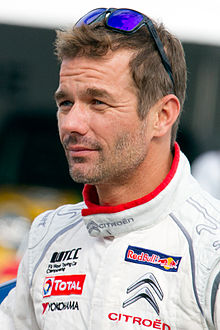
Most of the works drivers of the 1950s were amateurs, paid little or nothing, reimbursed their expenses and given bonuses for winning (although there were certainly exceptions, such as the Grand Prix drivers who were brought in for some events). Then in 1960 came arguably the first rallying superstar (and one of the first to be paid to rally full-time), Sweden's Erik Carlsson, driving for Saab.
In the 1960s, the competitions manager of BMC, Stuart Turner, hired a series of brave and gifted young Finns, skills honed on their country's highly competitive gravel or snow rallies, and the modern professional driver was born. As special stage rallying spread around the world Scandinavian drivers were challenged by drivers from Italy, Germany, Britain, Spain and elsewhere.
Rally types

There are two main forms: stage rallies and road rallies. Since the 1960s, stage rallies have been the professional branch of the sport. They are based on straightforward speed over stretches of road closed to other traffic. These may vary from asphalt mountain passes to rough forest tracks, from ice and snow to desert sand, each chosen to provide an enjoyable challenge for the crew and a test of the car's performance and reliability.
The entertaining and unpredictable nature of the stages, and the fact that the vehicles are in some cases closely related to road cars, means that the bigger events draw massive spectator interest, especially in Europe, Asia and Oceania.

Road rallies are the original form, held on highways open to normal traffic, where the emphasis is not on outright speed but on accurate timekeeping and navigation and on vehicle reliability, often on difficult roads and over long distances. They are now primarily amateur events. There are several types of road rallies testing accuracy, navigation or problem solving. Some common types are: Regularity rally or a Time-Speed-Distance rally (also TSD rally, testing ability to stay on track and on time),[37] others are Monte-Carlo styles (Monte Carlo, Pan Am, Pan Carlo, Continental) rally (testing navigation and timing), and various Gimmick rally types (testing logic and observation).
Many early rallies were called trials, and a few still are, although this term is now mainly applied to the specialist form of motor sport of climbing as far as you can up steep and slippery hills. And many meets or assemblies of car enthusiasts and their vehicles are still called rallies, even if they involve merely the task of getting there (often on a trailer).
Rallying is a very popular sport at the "grass roots" of motorsport—that is, motor clubs. Individuals interested in becoming involved in rallying are encouraged to join their local automotive clubs. Club rallies (e.g. road rallies or regularity rallies) are usually run on public roads with an emphasis on navigation and teamwork. These skills are important fundamentals required for anyone who wishes to progress to higher-level events. (See Categories of rallies.) Short special stage practice events on public roads are in some countries organized by the local clubs, with a permission of the local police, the community normally using the road, and the road authority. The public road is closed during these by the organisers or the police.
Rally courses
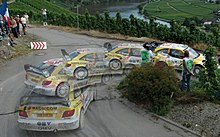
Rallying is also unique in its choice of where and when to race. Rallies take place on all surfaces and in all conditions: asphalt (tarmac), gravel, or snow and ice, sometimes more than one in a single rally, depending on the course and event. Rallies are also run every month of the year, in every climate from bitter cold to monsoonal rain. As a result of the drivers not knowing exactly what lies ahead, the lower traction available on dirt roads, and the driving characteristics of small cars, the drivers are much less visibly smooth than circuit racers, regularly sending the car literally flying over bumps, and sliding the cars out of corners.

A typical rally course consists of a sequence of relatively short (up to about 50 km (31 mi)), timed "special stages" where the actual competition takes place, and "transport stages" where the rally cars must be driven under their own power to the next competitive stage within a specific time limit in which penalties are applied for being completed either too fast as well as too slowly. Rally cars are thus unlike virtually any other top-line racing cars in that they retain the ability to run at normal driving speeds, and indeed are registered for street travel. Some events contain "super special stages" where two competing cars set off on two parallel tracks (often small enough to fit in a football stadium), giving the illusion they are circuit racing head to head. Run over a day, a weekend, or more, the winner of the event has the lowest combined special and super special stage times. Given the short distances of super special stages compared to the regular special stages and consequent near-identical times for the frontrunning cars, it is very rare for these spectator-oriented stages to decide rally results, though it is a well-known axiom that a team cannot win the rally at the super special, but they can certainly lose it.
Pacenotes and reconnaissance
Pacenotes are a unique and major tool in modern rallying. Television spectators will occasionally notice the voice of a co-driver in mid-race reading the pacenotes over the car's internal intercom. These pacenotes provide a detailed description of the course and allow the driver to predict conditions ahead and prepare for various course conditions such as turns and jumps.
In many rallies, including those of the World Rally Championship (WRC), drivers are allowed to run on the stages of the course before competition and create their own pacenotes. This process is called reconnaissance or recce. During reconnaissance, the co-driver writes down shorthand notes (the pacenotes) on how to best drive the stage. Usually the drivers call out the turns and road conditions for the co-drivers to write down. These pacenotes are read aloud through an internal intercom system during the actual race, allowing the driver to anticipate the upcoming terrain and thus take the course as fast as possible.
Other rallies provide organizer-created "route notes" also referred to as "stage notes" and disallow reconnaissance and use of other pacenotes. These notes are usually created using a predetermined pacenote format, from which a co-driver can optionally add comments or transpose into other pacenote notations. Many North American rallies do not conduct reconnaissance but provide stage notes through the use of the Jemba Inertia Notes System, due to time and budget constraints.[38]
In the past, most rally courses were not allowed to be scanned prior to the race, and the co-drivers used only maps supplied by the organization. The exact route of the rally often remained secret until race day. Modern rallies have mostly converted to using organizer-supplied notes or allowing full reconnaissance, as opposed to racing the stages blindly. This change has been brought on in large part due to competitor demand.
Historic rallying

In the wake of the ever more advanced rally cars of the 21st century is a trend towards historic rallying (also known as classic rallying), in which older cars compete under older rules.[39][40] This is a popular sport and even attracts some previous drivers back into the sport. Many who enter, however, have started their competition careers in historic rallying.
Film
In February 2015, The National Film & Television School in England premiered one of their graduating films called Group B directed by ex-rally driver Nick Rowland. The film, set during the last year of the Group B class of rally tells the story of a young driver having to face a difficult comeback after a "long and troubled absence". The young driver is played by Scottish actor Richard Madden, and his co-driver played by Northern Irish actor Michael Smiley.
The film features Group B class cars such as Ford RS200, Opel Manta and Tony Pond's MG Metro 6R4. The stunt driving in the film has been attributed to Rally America champion David Higgins.[41]
A documentary revolving around the life and career of World Rally Championship driver Ott Tänak entitled Ott Tänak: The Movie was released in Estonian cinemas on April 11, 2019,[42] and on video-on-demand in October 1, 2019.[43] The documentary consisted of interviews with Tänak, his family, friends and colleagues within the sport interspersed with filmed and archive footage of Tänak's previous rallies along with behind-the-scenes footage from the 2018 WRC season viewed from the Estonian driver's perspective.[44]
Rally driving techniques
- Double clutch
- Handbrake turn
- Heel-and-toe shifting
- Hill jumping
- Left-foot braking
- Scandinavian flick
- Trail braking
See also
- American Rally Association
- Andros Trophy
- Australian Rally Championship
- Canadian Rally Championship
- Cholistan Desert Jeep Rally
- Classic rally
- British Rally Championship
- European Rally Championship
- Intercontinental Rally Challenge
- National Auto Sport Association
- Rally raid
- Rallycross
- Regularity rally
- Road rally
- SCCA RallyCross
- United States National Championship (Rally America)
- Targa Newfoundland
- World Rally Championship
- Zero Car
References
- ^ Louche 2001 pp.44–79 & 377–384.
- ^ Pfundner 2005, p.45
- ^ Pfundner 2005, p.81
- ^ Hamilton, Maurice. RAC Rally (Partridge Press, 1987), p.9.
- ^ Delsaux, Jean-Paul. Marathon de la Route 1931/1971 (Jean-Paul Delsaux, 1991), p.7.
- ^ Hamill, Sammy. The Circuit of Ireland Rally: Fifty Years On (Tudor, 1981)", p.10.
- ^ Lurani, Giovanni. La Storia della Mille Miglia (De Agostini, 1979), p.7.
- ^ Delsaux 1991, p.27
- ^ Robson, p.45.
- ^ Hamilton 1987, p.17
- ^ Robson, p.46
- ^ Robson, p.55
- ^ Robson, p.55.
- ^ Louche, Maurice. Le Tour de Corse Automobile 1956–1986 (Maurice Louche, 1989), p.26.
- ^ Delsaux
- ^ Pfundner 2005 p 180
- ^ Lurani 1979, p.165
- ^ Louche 1989, p.56
- ^ Tunberg, Anders, and Haventon, Peter. Full fart genom Sverige: Svenska Rallyt 50 år (Full speed through Sweden: 50 years of the Swedish Rally). Bienen & Haventon, 2000.
- ^ Mäkinen, Marko, and Rauhala, Samuli. Finnish Grand Prix: 50 years of rallying (UserCom Finland Oy, 2001), p.9.
- ^ Hamilton 1987 p 30
- ^ Fangio, Juan Manuel, with Carozzo, Roberto. Fangio: My Racing Life (Patrick Stephens Ltd, 1990), p.50.
- ^ Fangio and Carozzo, p.92
- ^ Murphy, Daryl E: "Carrera Panamericana: History of the Mexican Road Race, 1950-54", page 12. iUniverse Inc.,2nd edition 2008.
- ^ Fromentin, Pierre: "16.000 km à travers l'Afrique", page 1. Plon, 1954.
- ^ Barnard, Roger: "Safari Rally: The First 40 Years", page 10. Westholme Publishing, 1992.
- ^ Tuckey, Bill, and Floyd, Thomas B: "Gregorys 25 Years of Around Australia Trials: From Redex to Repco", page 33. Gregory's Publishing 1979.
- ^ "British Columbia Trans-Canada and Shell 4000 Rally history project", shell-4000-rally.org, accessed 4 January 2019. https://web.archive.org/web/20160809133816/http://www.shell-4000-rally.org/index.htm
- ^ Fiolka, Marty: "1000 Miles to Glory: The History of the Baja 1000", page 35. David Bull 2005.
- ^ Brittan, Nick: "Marathon: Around the world in a cloud of dust". Motor Racing Publications, 1969.
- ^ Hudson-Evans, Richard, and Robson, Graham: "The Big Drive: The Book of the World Cup Rally 1970". Speed & Sports Publications, 1970.
- ^ Green, Evan: "A Boot Full of Right Arms: Adventures in the London-Sahara-Munich Rally and other Motoring Marathons", Cassell Australia 1975.
- ^ Stathatos, John. The Long Drive: The Story of the Singapore Airlines London-Sydney Rally. Pelham 1978.
- ^ Jones, Dot & Jim. Dakar: The Challenge of the Desert (Dinefwr, 2003), p.14.
- ^ "Veloce Books". veloce.co.uk. Retrieved 20 October 2010.
- ^ "1975 Lancia Stratos". sportscarmarket.com. Archived from the original on 9 May 2006. Retrieved 24 June 2007.
- ^ TSD Rally Retrieved 13 August 2006
- ^ Rallying Glossary Retrieved 13 August 2006.
- ^ UK HRCR's Historic Road Rally Retrieved 13 August 2006
- ^ Historic Rally Association (Australia) Retrieved 13 August 2006
- ^ Jalopnik Film Festival- Robb Stark Races In Rallying's Deadliest Era In New Film Group B films.jalopnik.com, accessed 4 January 2019
- ^ "Video: Ott Tänakust on valmimas dokumentaalfilm". Postimees Sport (in Estonian). 20 December 2018.
- ^ ""Ott Tänak - The Movie" on alates tänasest nähtav uues globaalses netikinos". Delfi Sport. Retrieved 2 October 2019.
- ^ "Varsti kinodes! Pilk kinnise loomuga ralliässa maailma: Vaata kõnekaid kaadreid Ott Tänaku dokist". Kinoportaal (in Estonian). 2019-01-25. Retrieved 2019-03-09.
External links
- FIA – Sanctioning body for the WRC
- World Rally Championship – WRC official website


